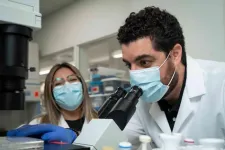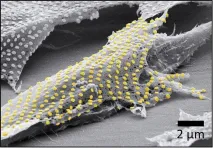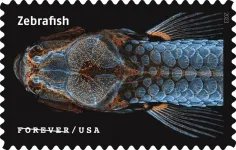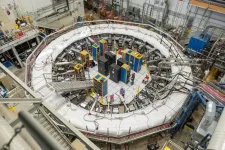(Press-News.org) LOS ANGELES — There are currently few effective treatment options for patients with recurrent ovarian cancer and other solid tumors, but City of Hope researchers are trying to change that.
Researchers with City of Hope, one of the largest cancer research and treatment organizations in the nation, have published preclinical research in Nature Communications demonstrating that a chimeric antigen receptor (CAR)-engineered T cell therapy worked against ovarian cancer in the laboratory and in preclinical models.
“City of Hope’s research helped develop CAR T cell therapies for blood cancers, and these patients are now seeing long-term benefits from the therapy, but we can’t stop there,” said Saul Priceman, Ph.D., associate professor in the Department of Hematology & Hematopoietic Cell Transplantation and associate director of Translational Sciences & Technologies in the T Cell Therapeutics Research Laboratories at City of Hope. “The next frontier is solid tumors, and City of Hope is taking on that challenge.”
The therapy is currently in a first-in-human Phase 1 trial at City of Hope for patients with advanced epithelial ovarian cancer who have already received platinum-based chemotherapy. The trial, led by Lorna Rodriguez-Rodriguez, M.D., Ph.D., City of Hope professor in its Division of Gynecologic Oncology, Department of Surgery, is testing the therapy’s safety, side effects and activity of the therapy in patients. The trial is currently enrolling patients for treatment.
Developing a CAR T cell therapy for solid tumors is particularly challenging because the therapy needs to first reach the solid tumor and then survive in a harsh microenvironment that is filled with cancer cells and other cells that prevent attack by the CAR T cells. But Priceman and his team have made significant progress in overcoming these challenges.
The team’s most recent research found that a CAR T cell therapy targeting TAG72, a target found on the surface of ovarian cancer cells, eradicates cancer cells in mouse models.
“What’s exciting about this is that TAG72 is also found on other cancer cells, including pancreatic, colorectal, breast and brain tumors, so if the clinical trial in ovarian does well, we can investigate expanding this to other patients,” he added.
CAR T cell therapy involves taking a patient’s T cells, a white blood cell that helps fight disease, from the bloodstream. T cells are then reprogrammed with a CAR in a City of Hope laboratory to recognize and attack a specific cancer-causing protein, such as TAG72, and reintroduced into the patient’s bloodstream. CAR T cells should then eradicate cancer cells. Patients are closely monitored for any side effects.
Priceman and his team also found that by adding the cytokine Interleukin-12 (IL-12), a protein that sends signals to the immune system, to the CAR T cell therapy, the treatment worked more effectively against cancer cells in the lab. The co-first authors Eric Hee Jun Lee and John P. Murad, Ph.D., along with the rest of the team, showed that IL-12 also enabled the T cells to both fight the cancer and leave the tumor area, enter the bloodstream and target other cancer cells around the body. Priceman noted that IL-12 is not currently part of the current Phase 1 clinical trial.
The preclinical research also found that delivering the CAR T cell therapy via an injection where the cancer is located, regionally, is also effective in enabling CAR T cells to target cancer elsewhere. This technology allows for both safety and improved anti-tumor activity in several cancer types tested to date.
“This therapy has been years in the making at City of Hope, so we are excited to finally see it in patients whose cancer is advanced and are in need of more treatments,” Priceman added.
# # #
About City of Hope
City of Hope's mission is to deliver the cures of tomorrow to the people who need them today. Founded in 1913, City of Hope has grown into one of the largest cancer research and treatment organizations in the U.S. and one of the leading research centers for diabetes and other life-threatening illnesses. City of Hope research has been the basis for numerous breakthrough cancer medicines, as well as human synthetic insulin and monoclonal antibodies. With an independent, National Cancer Institute-designated comprehensive cancer center at its core, City of Hope brings a uniquely integrated model to patients spanning cancer care, research and development, academics and training, and innovation initiatives. City of Hope’s growing national system includes its Los Angeles campus, a network of clinical care locations across Southern California, a new cancer center in Orange County, California, and treatment facilities in Atlanta, Chicago and Phoenix. City of Hope’s affiliated group of organizations includes Translational Genomics Research Institute and AccessHopeTM. For more information about City of Hope, follow us on Facebook, Twitter, YouTube, Instagram and LinkedIn.
END
SAN DIEGO (AUG. 10, 2023) — A new study on gray-necked rockfowl has found a much smaller range of suitable habitat for this elusive African bird than was previously assumed, and may warrant a downgrade in its conservation status.
Scientists from the Cameroon Biodiversity Association (CAMBIO) in Cameroon, in partnership with San Diego Zoo Wildlife Alliance, set out to better understand how much suitable habitat remains for the rockfowl, and where the birds can still be found.
Understanding suitable habitat and its extent is crucial for protecting species. However, scientists have limited knowledge ...
Physicians, psychologists, advanced practice providers, dietitians, and others who are committed to treating and preventing obesity in Louisiana have come together to formally launch the Louisiana Obesity Society, a new statewide professional organization. The Louisiana Obesity Society will be hosting its inaugural annual conference in conjunction with the Louisiana Chapter of American Society of Metabolic and Bariatric Surgery on Saturday, Aug. 12, at the Renaissance New Orleans Arts Warehouse District Hotel in New Orleans.
The Louisiana Obesity Society was created to support providers treating obesity through education and networking. The society will also advocate ...
Although millions are spent each year on entrepreneurship training that is intended to help alleviate poverty and elevate the quality of life of entrepreneurs in developing nations, these programs often fail to make an impact.
Brigham Young University professors Shad Morris and Chad Carlos, along with three other colleagues, were invited by the Tanzania Social Action Fund (“TASAF”) to see if they could help figure out why TASAF’s entrepreneurship trainings were not producing the results they were hoping for.
In order to assist TASAF, Morris, Carlos, and colleagues Geoff Kistruck, Elly Tumsifu and Bob Lount, carried out an extensive ...
For now, cyborgs exist only in fiction, but the concept is becoming more plausible as science progresses. And now, researchers are reporting in ACS’ Nano Letters that they have developed a proof-of-concept technique to “tattoo” living cells and tissues with flexible arrays of gold nanodots and nanowires. With further refinement, this method could eventually be used to integrate smart devices with living tissue for biomedical applications, such as bionics and biosensing.
Advances in electronics have enabled manufacturers ...
Long COVID can persist for at least a year after the acute illness has passed, or appear months later, according to the most comprehensive look yet at how symptoms play out over a year.
The multicenter study, a collaboration between UC San Francisco, the Centers for Disease Control and Prevention (CDC) and seven other sites, expands knowledge of post-COVID-19 conditions, describing trends in more detail than previous research and highlighting significant impacts the epidemic has had on the U.S. health care system.
The study appears Aug. 10, 2023, in Morbidity and Mortality Weekly Report (MMWR), ...
Open Access publisher PeerJ have announced their second Editor-in-Chief partnership for the Open Advances series of journals. Professors Ute Roessner and Luis E. Eguiarte have agreed to take on the leadership of PeerJ Open Advances in Plant Science as Co-Editors-in-Chief.
Professors Roessner and Eguiarte are highly respected, award-winning scientists working at the forefront of their fields. As Co-Editors-in-Chief they will provide the scientific leadership for the journal, starting with recruiting an Editorial Board who will ...
A microscopy image created by National Institutes of Health researchers is part of the “Life Magnified” stamp panel issued today by the United States Postal Service (USPS®). The NIH zebrafish image, which was taken to understand lymphatic vessel development in the brain, merges 350 individual images to reveal a juvenile zebrafish with a fluorescently tagged skull, scales and lymphatic system.
“Zebrafish are used as a model for typical and atypical human development. It is surprising how much we have in common with ...
Brazilian researchers combined environmental physical, social and economic indicators to create an index that measures a region’s vulnerability and used it to analyze the basins of the Parnaíba River and São Francisco River in the Northeast of Brazil. The index is named SEVI (for Socio-Environmental Vulnerability).
The Parnaíba and São Francisco basins are considered crucial to agricultural expansion and biodiversity conservation. They contain more than 780 municipalities and part of the semi-arid Caatinga and savanna-like Cerrado biomes, which are threatened ...
ROCHESTER, Minn. — Using human "mini-brain" models known as organoids, Mayo Clinic and Yale University scientists have discovered that the roots of autism spectrum disorder may be associated with an imbalance of specific neurons that play a critical role in how the brain communicates and functions. The specific cells are known as excitatory cortical neurons.
The new study is published in Nature Neuroscience.
Findings
The team found an abnormal imbalance of excitatory ...
Batavia, Ill., Aug. 10, 2023 – Physicists now have a brand-new measurement of a property of the muon called the anomalous magnetic moment that improves the precision of their previous result by a factor of 2.
An international collaboration of scientists working on the Muon g-2 experiment at the U.S. Department of Energy’s Fermi National Accelerator Laboratory announced the much-anticipated updated measurement on Aug. 10. This new value bolsters the first result they announced in April 2021 and sets up a showdown between theory and experiment over 20 years in the making.
“We’re really probing new territory. We’re determining ...







